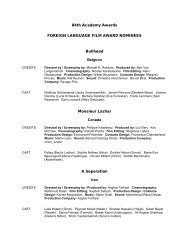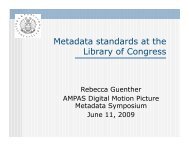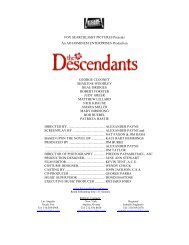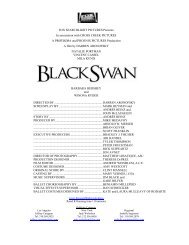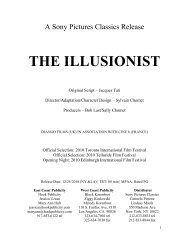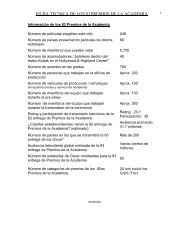Download Report - Academy of Motion Picture Arts and Sciences
Download Report - Academy of Motion Picture Arts and Sciences
Download Report - Academy of Motion Picture Arts and Sciences
You also want an ePaper? Increase the reach of your titles
YUMPU automatically turns print PDFs into web optimized ePapers that Google loves.
other art directors as a system which might be used<br />
with interesting results, for I personally have not<br />
developed it beyond the experimental stage. Its<br />
efiects are probably due to the fact that liehl vibrations<br />
<strong>of</strong> difierent colors do not focus on th. ,u-.<br />
plane in the retina <strong>of</strong> the eye, <strong>and</strong> as one recedes<br />
<strong>and</strong> another advances we get an effect <strong>of</strong> depth.<br />
When we come to paint a difficult set, we suddenly<br />
get very friendly with the cameraman. We<br />
realize he probably knows better than we do how<br />
a color will photograph, but does he know ',Why?,,<br />
It is that "*hy" we want to arrive at, so the object<br />
<strong>of</strong> my talk tonight is to lead up to that question.<br />
Mn. Vorcx: We are honored to have with us<br />
tonight a famous research engineer, a man <strong>of</strong> international<br />
fame, Mr. Loyd A. Jones, <strong>of</strong> the Kodak<br />
Research Laboratories, Rochester. N. Y.. who rvill<br />
read a paper on "Color Values Under Inc<strong>and</strong>escent<br />
Tungsten Illumination."<br />
MR. JONES' PAPER<br />
ON COLOR VALUES<br />
In the analysis <strong>of</strong> the effects produced by the action<br />
<strong>of</strong> certain definite causesr we may be content<br />
in some cases to describe the observed reiults in qualitative<br />
terms. Thus, in dealing with the question o{<br />
the photographic rendition <strong>of</strong> color under any specified<br />
conditions <strong>of</strong> illumination <strong>and</strong> photographic<br />
material characteristics, we mav sav that a red<br />
object is rendered as a lighter ton. Lf gray when<br />
photographed (on Panchromatic film) tnder Inc<strong>and</strong>escent<br />
Tungsten illumination than when photographed<br />
by the light from a sun arc. Such a statement<br />
is, however, far from satisfactorv to the critical<br />
student <strong>of</strong> such problems who undbubtedly will<br />
ask immediately, what particular red are you talking<br />
about <strong>and</strong> how much Tighter is it rendered under<br />
tungsten illumination. He desires <strong>and</strong> needs<br />
not only qualitative information. but also quantitative<br />
information, so that he may know definitely the<br />
effect produced by the use <strong>of</strong> tungsten illumination.<br />
Nor is he yet satisfied; for if he is to fullv underst<strong>and</strong><br />
the photographic tonal rendition <strong>of</strong> colored<br />
objects, to be able to apply his knowledge to practical<br />
problems, <strong>and</strong> to predict with certainty the<br />
tonal rendition <strong>of</strong> any color under any illumination<br />
<strong>of</strong> specified quality, he will surely want to know<br />
why rcd is rendered as a lighter tone <strong>of</strong> gray when<br />
tungsten lamps are used for illuminatine the red<br />
object. Thus, to fully satisfy the requiriments <strong>of</strong><br />
complete underst<strong>and</strong>ing, we must be prepared to<br />
lupply not only qualitative (how?) in{ormation,<br />
but also quantitative (how much?) data; <strong>and</strong> further<br />
to explain zthy the observed results occur.<br />
Perhaps some individuals, <strong>of</strong> the so-called practical<br />
school, may feel that they are not particularly<br />
concerned with those theoretical aspects which are<br />
involved in explaining why certain effects are produced,<br />
but may be quite satisfied with a knowledee<br />
<strong>of</strong> zuhat happens. However, I believe firmlv in the<br />
premise that the nearest approach to perfection in<br />
the practice <strong>of</strong> a scieirce can be attained with sreater<br />
facility <strong>and</strong> certainty through an adequate knowledge<br />
<strong>of</strong> the theoretical aspects <strong>of</strong> the subiect. The<br />
earlier parts o{ this paper, therefore, will be devoted<br />
to a discussion <strong>of</strong> certain essential physical<br />
<strong>and</strong> psychophysical laws <strong>and</strong> relationships which<br />
must be understood in order to explain why colors<br />
are rendered as they are under tungsten <strong>and</strong> other<br />
illuminants.<br />
The fundamental knowledge essential to a complete<br />
underst<strong>and</strong>ing <strong>of</strong> the photographic rendition<br />
<strong>of</strong> colored objects may, for convenience, be classified<br />
as follows: (a) The quality or spectr:al comfosition<br />
<strong>of</strong> the radiation emitted by the various light<br />
sources in which we are interested. (b) The characteristics<br />
<strong>of</strong> the human eye as a sense organ responding<br />
to stimulation by radiant energy o{ various<br />
wave-lengths. (c) The characteristics <strong>of</strong> the objects<br />
which it is desired to photograph, particularly their<br />
capacity to reflect or transmit radiant energy <strong>of</strong><br />
various wave-lengths. (d) The characteristics <strong>of</strong><br />
photographic materials as light sensitive receptors<br />
responding to rad,iant energy <strong>of</strong> various wavelengths.<br />
We shall now proceed to a detailed consideration<br />
<strong>of</strong> each <strong>of</strong> these subdivisions in the order<br />
mentioned.<br />
When radiant energy <strong>of</strong> certain definite wavelengths<br />
falls upon the retina <strong>of</strong> the eye, a sensation<br />
is produced which we call light. Thus, radiant energy,<br />
a purely physical or objective phenomenon,<br />
when allowed to act upon one <strong>of</strong> our sense organs,<br />
the retina, serves as a stimulus producing a subjective<br />
sensation or response which in general is designated<br />
as light. Likewise, when radiant energv oi<br />
certain wave-lengths, which may or may not be the<br />
same as those producing the sensation <strong>of</strong> light, falls<br />
upon a photographic plate or film, a resfonse (latent<br />
image) occurs which by development can be rendered<br />
visible <strong>and</strong> used as a means <strong>of</strong> producing a<br />
pictorial representation <strong>of</strong> the objects from which<br />
this radiation emanated. In order to analyze precisely<br />
the correctness <strong>of</strong> tonal rendition obtained by<br />
using any particular illuminant or source o{ radiation<br />
for the reproduction <strong>of</strong> a series o{ colored objects<br />
by the photographic process, it obviously is<br />
necessary to have quantitative knowledge relative<br />
to the characteristics <strong>of</strong> the radiation in question as<br />
well as to underst<strong>and</strong> the nature <strong>of</strong> both the visual<br />
<strong>and</strong> photographic responses to this radiation.<br />
It is assumed, in this discussion <strong>of</strong> the rendition<br />
<strong>of</strong> color values under tungsten illumination, that<br />
we are concerned only in the use <strong>of</strong> panchromatic<br />
photographic materials, <strong>and</strong> moreover, that we are<br />
interested in the rendering <strong>of</strong> colors when tungsten<br />
illumination is used as compared with the rendition<br />
obtained by.the use o{ other available illuminants.<br />
Since the quality <strong>of</strong> the radiation emitted by an illuminant<br />
has a pr<strong>of</strong>ound inlluence upon the photographic<br />
rendition <strong>of</strong> colors, it will be necessary, first<br />
o{ all, to consider the way in which the quality o{<br />
tungsten rad.iation differs from, or is similar to that<br />
<strong>of</strong> the radiation emitted by other commonly used<br />
light sources.<br />
The quality, or spectral composition <strong>of</strong> radiation,<br />
f ta1<br />
L 2/ )





